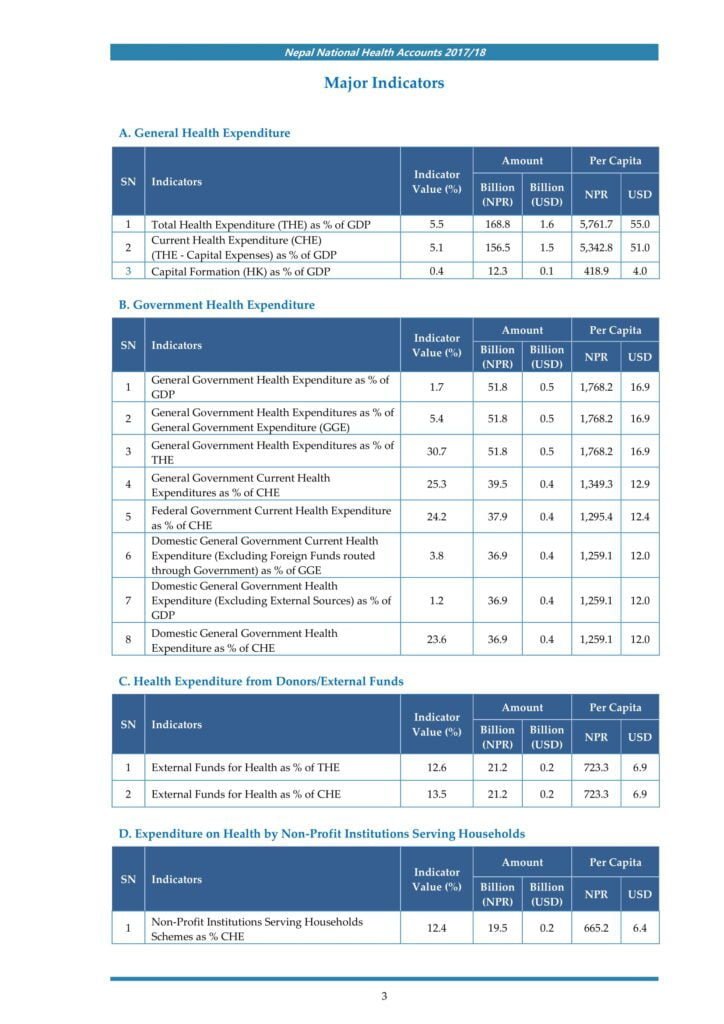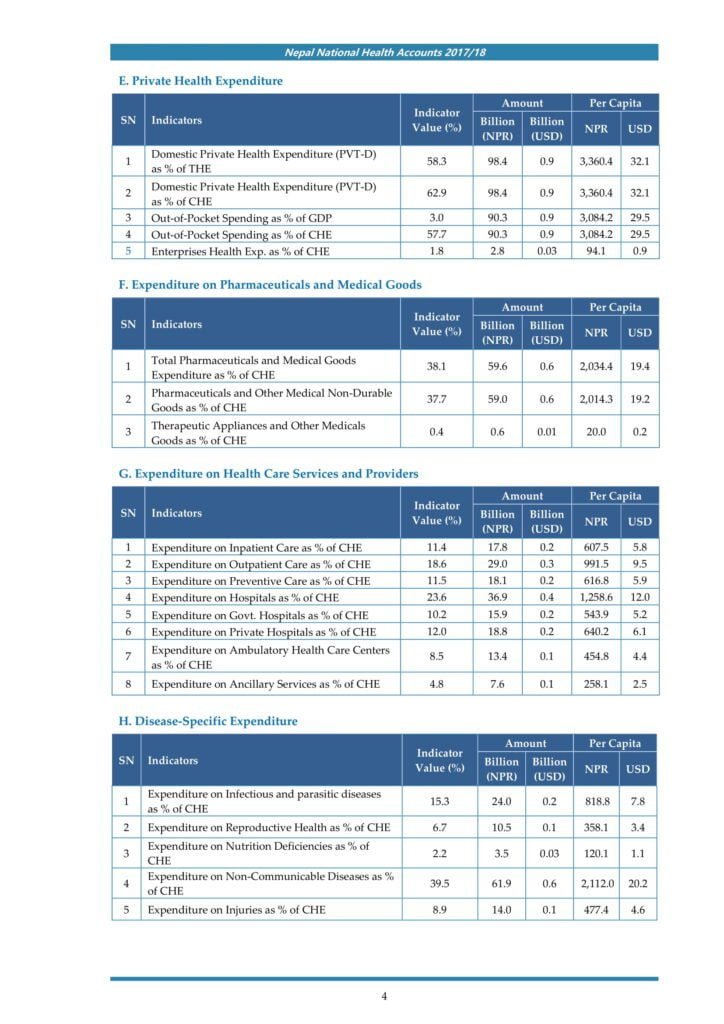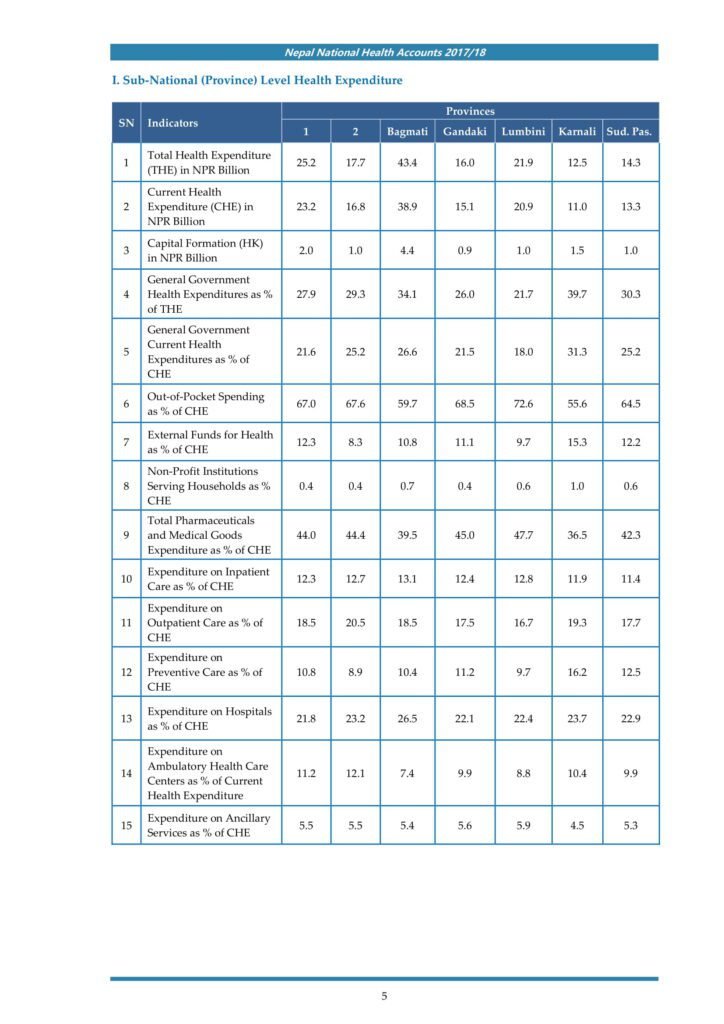About Nepal National Health Accounts
The Nepal National Health Accounts 2017/18 report was prepared adhering to System of Health Accounts 2011 (SHA 2011), a global standard framework for producing health accounts with necessary refinements relevant to the country context.
This report provides the estimates of healthcare expenditures occurred in the health system of Nepal estimated based on the pre established expenditure boundaries, data sources, classification codes and estimation methodology. All reasonable precautions have been taken to justify the information presented in this publication. The estimates presented in this report could be further improved. Readers are welcome to contact the NHA team with suggestions and/or for further clarifications.
Recommended reading: Nepal National Health Accounts 2016/17
This report does not present or suggest the policy implications of healthcare expenditures. While limited analysis has been done in this report, it is the responsibility of the readers and stakeholders to use, interpret, and draw inferences from the data in this publication.
Objective
This round of NHA exercise was conducted between October 2019 and November 2020. The primary objective was to estimate and track the flow and level of spending by various entities such as government, households, external donors, national and international NGOs, private sectors, employers, insurance providers, etc. in the country’s health system and how the funding was used to deliver the health services and goods to the people.
The purpose was to understand the country’s health financing landscape and mechanism for evidence-based policymaking. The aim was to create demand and use health accounts to answer the key policy questions and inform policy decisions for health financing reforms. The key questions that this round of NHA intended to answer include:
- How much did Nepal spend on healthcare? Who funds the healthcare in Nepal and how much did they contribute?
- How sustainable are the overall resources for health in Nepal?
- How were the healthcare funds managed and distributed? What is the role of government and donors in managing health care resources in Nepal?
- What inputs were used to produce and deliver the overall healthcare services?
- Who managed the healthcare funds in Nepal? What was the share of household out-of-pocket in overall healthcare financing in Nepal?
- Who used the funds to deliver the healthcare services and how was the fund distributed at different levels of the health system of Nepal?
- What kinds of healthcare services and goods were purchased with the healthcare funds?
- Which diseases and health conditions Nepal spent on?
- How is the health resource flow at the subnational level? Who finances health care and how the funds are managed and distributed at the provinces?
Executive Summary
Health Accounts aim to provide a systematic, comprehensive, and consistent record of health expenditure by estimating expenditure on the consumption of health services and goods in a country for the reference year. It provides a comprehensive understanding of the health financing system and the multisectoral contribution to a country’s health sector. Health Accounts track the expenditure of different sectors such as government, households, external donors, national and international nongovernmental organizations, private sector, employers, insurers, etc. in the country’s health system and how the funds were used to provide health services and goods to the population. Tracking health expenditure is an important decision making tool for policy and planning purposes.
Nepal has been conducting health accounts since 2000, and six rounds of Nepal National Health Accounts (NHA) have been completed so far. This is the seventh round of NHA, covering the 2017/18 fiscal year. The objective was to understand the landscape of health financing mechanisms in the country through evidence based on health expenditure estimates and find answers to key policy questions. In this round of NHA, necessary adjustments were made to some variables, the disease
account, further analysis of capital expenditure continues and for the first time, an estimate of health expenditure at the sub-national level is carried out, which becomes relevant as this is the year that decentralization was operationalized.
New on this report
- This is the 7th round of NHA conducted by Nepal.
- This round of NHA estimates was based on the six-dimensional classification of the System of Health Accounts (SHA) 2011 Framework.
- Health expenditure data were compiled from various primary and secondary sources and checked for completeness, comprehensiveness, consistency, and plausibility.
- The Health Accounts Production Tool (HAPT) was used for data validation and analysis.
- This round of NHA estimates that noncommunicable disease spending has increased since the fiscal year 2016/17 which accounted more than half of the total CHE for the disease category.
Facts
- Current health expenditure (CHE) in nominal prices was estimated at NPR 156.5 billion (5.1% of GDP) in 2017/18 and capital expenditure at NPR 12.3 billion (0.4% of GDP).
- Capital expenditure has declined slightly since the fiscal year 2016/17, with more than half of the total investment going to new and upgraded buildings.
- Total Health Expenditure (THE), which is the sum of CHE and capital expenditure, was estimated at NPR 168.8 billion (USD 1.6 billion), equivalent to 5.5% of GDP, and per capita expenditure was NPR 5761.7 (USD 55.0) in 2017/18.
- General Government Health Expenditure (GGHE) using all sources (recurrent and capital) amounted to NPR 53.1 billion (USD 0.5 billion), which was about one-third of THE and 5.5% of total government expenditure.
- The share of GGHE in GDP was estimated at 1.7%.
- The share of GGHE in CHE slightly increased from 25.3% since the fiscal year 2016/17 to 26.1% in the fiscal year 2017/18.
- In the federal government system, the MoHP was the largest agency for managing government health expenditure, accounting for about 37.1% of GGHE, followed by provincial and local governments with about 33.5% and other ministries and public bodies 25.5%.
- Curative care accounted for the largest share of government health expenditure in 2017/18 (47.3%), followed by preventive care (14.9%).
- Total external funding for health was estimated at 13.5% of CHE, which includes direct foreign transfers and foreign transfers distributed for health through the government.
- Of the non-government transfers, more than half came from private donors, philanthropic organizations, and the remainder from bilateral and multilateral organizations (1.9% and 2.5% of CHE).
- Household OOP payments for health care were the largest source and payer for their health care, with a share of 57.7% of the current health expenditure in Nepal’s health system.
- The estimated household OOP expenditure was NPR 90,340.3 million (per capita NPR 3,084.2; USD 29.5).
- As much as 65.6% of OOP payments for health care were for pharmaceuticals and medical supplies, followed by curative care at 23.2%. OOP at hospitals was estimated at 20.8% of total OOP where majority (16.6% of total OOP) was made at the private hospitals and the OOP at public hospitals was 4.2% of total OOP.
- An analysis of disease-related expenditure shows that non-communicable diseases accounted for more than half of total household OOP expenditure.
- As much as 38.1% of CHE was spent on pharmaceuticals and medical supplies, while curative care took up about 31.5% of CHE, where around 18.6% and 11.4% of CHE was spent on outpatient and inpatient care respectively.
- Preventive and promotive care services claimed about 11.5% of CHE, which has declined since the fiscal year 2016/17.
- In the FY 2017/18, total spending on medical laboratories, imaging, and patient transportation was estimated at 4.8% of CHE.
- This round of NHA estimates that noncommunicable disease spending has increased since the fiscal year 2016/17 which accounted more than half of the total CHE for the disease category, that could be classified. The CHE for infectious and parasitic diseases was 15.3%.
- Health expenditure estimates for the health provider classification showed that there was more expenditure in non public hospitals than in public hospitals (12.3% vs. 10.2% of CHE). Among public health care facilities, health care expenditures in public primary care facilities, was 7.1% of CHE.
- Health expenditures incurred exclusively in primary health care facilities (both public and non-public) were estimated at 8.5% of CHE, a slight increase since the fiscal year 2016/17.
- The government source was the main source of funding for public health facilities, although in public facilities foreign sources and household OOP made significant financial contributions.
Provincial status
- The distribution of health expenditure by province showed that Bagmati Province had the highest share of current and capital health expenditure, with provincial THE estimated at NPR 43.4 billion, followed by Province 1 and Lumbini Province with provincial THE of NPR 25.2 billion and NPR 21.9 billion, respectively. Karnali Province had the lowest provincial THE, estimated at NPR 12.5 billion.
- About 11% of the national level Total Health Expenditure could not be distributed to the provinces.
Major Indicators



Download: Nepal National Health Accounts 2017/18
MOHP (2022). NEPAL NATIONAL HEALTH ACCOUNTS 2017/18, MINISTRY OF HEALTH AND POPULATION, KATHMANDU.
Related document
- Nepal National Health Accounts 2016/17
- Progress of the Health and Population Sector, 2020/21 (NJAR Report)
- Dissemination of Findings and Recommendations of Joint External Monitoring Mission(JEMM) of Nepal National Tuberculosis Program
- Emergency Contraceptive Pills (ECP) Program Implementation Guideline 2078
- National Standards on WASH for Health Institutions 2078
- Pocket Book of Clinical Management of COVID-19 in Healthcare Setting: 2nd Edition with Revision
- Tuberculosis Free Nepal Declaration Initiative Implementation Guideline
Do you have a website? Looking for the best hosting provider? Here’s a discount code.
Latest Public Health Jobs
Latest Posts
- Global Tuberculosis Report 2025
- Postdoctoral Fellowship
- Responding to the health financing emergency: Immediate response and longer-term shifts
- Nepal: Information sheet on climate change, air pollution, and health
- Taking a strategic approach to urban health: a guide for decision-makers
Thanks for visiting us.
Disclaimer: The resources, documents, guidelines, and information on this blog have been collected from various sources and are intended for informational purposes only. Information published on or through this website and affiliated social media channels does not represent the intention, plan, or strategies of an organization that the initiator is associated with in a professional or personal capacity, unless explicitly indicated.
If you have any complaints, information, or suggestions about the content published on Public Health Update, please feel free to contact us at blog.publichealthupdate@gmail.com.
#StayUpdated


